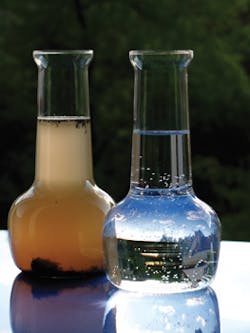The New American Dream: Water Quality Trading
Nutrients such as phosphorous and nitrogen are being seen as a curse and a blessing: the cause of algal blooms yet a harvestable commodity. With runoff from farms having to be treated by waterworks, should there be more communication between the agricultural and water sectors? NACWA believes water quality is one answer. Hannah Mellman reports.
America's wastewater sector is facing an uphill battle. With some of the country's water infrastructure systems built before the Civil War, it is no surprise these fragile networks are in need of serious attention. The U.S. Environmental Protection Agency (EPA) estimates that repairing, replacing, and upgrading aging wastewater infrastructure will cost between $300 billion to $1 trillion over the next 20 years. As things stand today, ratepayers are shouldering approximately 97% of this financial burden, with municipalities spending over $100 billion per year on clean and safe water investments.
In addition to this growing investment need, EPA regulations on wet weather-related discharges, biosolids management and nutrients under the 1972 Clean Water Act (CWA) have expanded. As a result, this has lead to more expensive levels of wastewater treatment. Given the current economic environment and federal budget shortfall, how can publicly owned treatment works (POTWs) make the necessary upgrades to protect public health and the environment without going bankrupt or increasing rates to unsustainable levels?
For over 40 years, utilities have been at the crux of this challenge, pursuing national policies and approaches that seek to stretch every ratepayer dollar as far as possible in order to ensure that the nation's waters are clean and safe, and meet the strict requirements of the CWA.
The nutrient challenge
Excessive amounts of nutrients, primarily nitrogen and phosphorous in waterways now represents the single largest pollution problem facing US waters. More than 60% of the rivers and bays in every coastal state are moderately to severely degraded by nutrient pollution. Nutrients are contributing to some of the largest algal blooms, fish kills, shellfish poisonings and aquatic deadzones in the country.
Effluent discharges from POTWs are a significant source of nutrient pollution in surface waters. As a result, EPA has increased its focus on controlling nutrient discharges from these sources. Yet POTWs are not the only nor the greatest source of nutrient pollution in many waterways.
Runoff from agricultural land, rich in nutrients from fertilizer and livestock manure, is responsible for high levels of nutrient pollution. Despite this, most agricultural producers are exempt from the water pollution control requirements of the CWA.
This leaves the brunt of the work to mitigate nutrient pollution to the POTWs, which rely on expensive technology controls and upgrades to reduce their nutrient loadings. While these utilities strive for compliance, there are two problems with this model.
First, nutrient removal technology is extremely expensive. In the Chesapeake Bay for example, EPA recently issued a permit to the Blue Plains Wastewater Treatment Plant in Washington, D.C., requiring a further reduction in effluent nitrogen from just over five million to 4.7 million pounds per year. This nitrogen removal project will incur a capital cost of $900 million to ratepayers yet only result in a 0.4% reduction of total nitrogen flowing into the Chesapeake Bay.
And second, even if a utility is able to completely remove the nutrients from its discharge, it may not lead to sizable reductions in overall nutrient loads in waterways and improvements in water quality. In the Midwest, nutrient pollution in the Mississippi River is responsible for a deadzone in the Gulf of Mexico that measures almost 3,000 square miles. Yet, POTWs are only responsible for 12% of the phosphorous and 9% of the nitrogen delivered to the Gulf, compared to agricultu/ral and range land, which is responsible for 80% and 71% respectively.
Clearly, there is a disconnect between current water quality management and implementation practices and what is needed to improve water quality. Instead, a more holistic approach to watershed management should be adopted to collectively engage and address all sources and activities contributing to nutrient pollution.
Water Quality Trading to address nutrient pollution
Water quality trading continues to gain interest among industry and agricultural producers as a viable market-based alternative to control water pollution. This approach is based on the idea that pollution sources in a watershed face very different costs to control the same pollutant.
So, permitted emitters like POTWs with high abatement costs could purchase equivalent nutrient reductions from a cheaper source, like agriculture, to help meet their regulatory requirements.
There are three main benefits to water quality trading. First, water quality trading has the potential to meet nutrient load requirements at lower overall costs. The cost to remove a pound of nitrogen or phosphorus from farm runoff and drainage is typically four to five - and sometimes up to 10 to 20—times less than the cost to remove the same amount from municipal wastewater or stormwater.
Secondly, the economic incentive created for farmers who engage in nutrient management activities means that water quality trading can potentially generate environmental benefits beyond those that would be achieved under traditional regulation, like wildlife habitat and floodwater control.
Finally, water quality trading helps move water quality control efforts towards a watershed-based approach, collectively addressing all sources and activities contributing to watershed degradation.
It is easy to see why a POTW, stretched beyond the brink of its financial capacity, would see water quality trading as appealing. This approach can address the lowest-hanging fruit in terms of nutrient reduction, saving utilities money, engaging sectors that may not otherwise participate in nutrient reduction activities. This is as well as encouraging water quality improvements that go above and beyond minimum pollution control requirements.
Updating EPA's Water Quality Trading policy
According to the EPA, there are currently 49 water quality trading programs active or under development in the U.S. Of those, less than half include trading between utilities and agricultural and fewer still are geared specifically towards addressing nutrients.
If the environmental and economic benefits of adopting a market-based approach to meet nutrient requirements are overwhelmingly positive, why haven't these markets been more readily adopted?
Successful water quality trading programmes depend on quite a few factors. These include the ability to establish and enforce a pollution cap, handle the complexity associated with establishing verifiable agricultural credits, and avoid the creation of hot spots, or localized areas with high levels of nutrients within a watershed. Equally important is the need for more consistent support and greater promotion of water quality trading from the federal government.
In 2003, EPA released its Water Quality Trading Policy to provide states and interstate agencies with guidance in developing and implementing water quality trading programs. This Policy is the first time EPA has recognised water quality trading as a viable approach to reducing certain types of water pollution. Its release signified a broader shift in environmental policymaking from top‐down strategies to one that fosters commodification and local ownership.
While it is certainly positive to see EPA endorse a market-based approach to nutrient management, NACWA has urged EPA to update the policy and clarify language the Association fears could in fact limit trading and the broader establishment of regional water quality trading programs.
First and foremost, the National Association of Clean Water Agencies (NACWA) urges EPA to encourage water quality trading if trading can meet environmental goals equal to or greater than those under existing regulatory programs, not only where trading achieves greater environmental benefits as the Policy states. Achieving ancillary environmental benefits is certainly encouraged but trading should not be disregarded if a program is capable of achieving environmental benefits equal to those under regulation at less cost.
Secondly, NACWA is concerned with how the Policy defines the areas under which trading may occur. According to EPA's Policy, "All water quality trading should occur within a watershed or a defined area for which a Total Maximum Daily Load (TMDL) has been approved."
Under the CWA, a waterbody that fails to meet one or more of its designated uses is declared 'impaired' and a TMDL is developed, which allots a maximum amount of a pollutant the waterbody can receive and still safely meet water quality standards. TMDLs can certainly help facilitate trading as they define a trading area and establish a pollution cap for each pollution source. Nevertheless, NACWA fears EPA's Policy could be interpreted as only endorsing trading where a TMDL has been established.
Relying on a TMDL to establish a trading program is constraining and could hamper the development of new domestic markets. Around the country, many segments of streams and rivers, lakes, and coastal waterbodies are facing enormous nutrient problems despite not being declared impaired or having a TMDL.
Furthermore, implementing a TMDL is a cumbersome and, at times, contentious process. It requires setting a controversial pollution limit to be recognized by pollution control mandates on some or all pollution sources. In cases where agriculture is involved, translating broad mandates to individual producers and ensuring long-term compliance is especially difficult.
Water Quality Trading trial
It is critical the EPA recognizes that trading can be just as effective, if not more so, in the absence of a TMDL. The Electrical Power Research Institute's (EPRI) Ohio River Basin Trading Project is one example of a voluntary nitrogen and phosphorous trading program not linked to a TMDL.
In August 2012, EPRI launched the pilot phase of the Project, which covers parts of Ohio, Kentucky, and Indiana. It is the only active interstate trading program in the country and on its way to being one of the largest and most sophisticated water quality trading programs ever developed. To see the implementation of more programs like EPRI's, EPA should be receptive to water quality trading programs under a wide variety of circumstances.
Finally, NACWA is concerned that baseline requirements for agriculture may hinder trades in water quality trading programs. According to EPA, farmers must first comply with baseline, or pollutant control requirements, before they can be eligible to generate and sell credits. Baseline requirements take the form of best management practices (BMPs) that are consistent with the water quality goal.
Under the CWA, there are no requirements for agriculture to adopt BMPs even in the presence of a TMDL. By requiring a minimum practice standard to participate in a trading program, EPA is disqualifying the least costly reductions from being offered as offsets.
Farmers who have not voluntarily adopted the minimum set of practices prior to the start of a trading program may not find it in their interest to enter the market because of the entry cost associated with meeting a baseline. NACWA fears this competitive disadvantage could ultimately limit participation, hampering credit supply and adversely affect market efficiency.
Although it is unclear whether EPA is open to revising the Water Quality Trading Policy in the near future, EPA has requested a meeting with NACWA to continue this discussion. NACWA is encouraged by this request, and plans to continue work with EPA and other stakeholder groups to develop water quality trading policies and programs that will yield tangible water quality and environmental improvements while addressing the affordability concerns of POTWs around the country.
Author note: Hannah Mellman is manager of legislative affairs for the National Association of Clean Water Agencies (NACWA). For more information please email: [email protected].
Working Group
NACWA recently formed a Water Quality Trading Working Group to provide a utility perspective on whether trading can achieve more efficient water quality improvements. While the Association has weighed in on trading issues in the past, this is the first time NACWA has formed a group dedicated to the issue, signifying the growing recognition that this approach can provide a credible alternative to traditional regulatory approaches.




